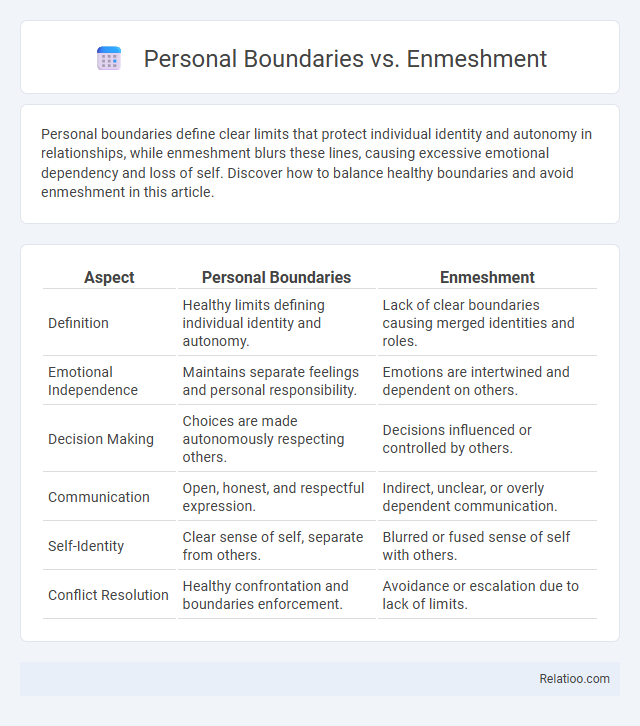Personal boundaries define clear limits that protect individual identity and autonomy in relationships, while enmeshment blurs these lines, causing excessive emotional dependency and loss of self. Discover how to balance healthy boundaries and avoid enmeshment in this article.
Table of Comparison
| Aspect | Personal Boundaries | Enmeshment |
|---|---|---|
| Definition | Healthy limits defining individual identity and autonomy. | Lack of clear boundaries causing merged identities and roles. |
| Emotional Independence | Maintains separate feelings and personal responsibility. | Emotions are intertwined and dependent on others. |
| Decision Making | Choices are made autonomously respecting others. | Decisions influenced or controlled by others. |
| Communication | Open, honest, and respectful expression. | Indirect, unclear, or overly dependent communication. |
| Self-Identity | Clear sense of self, separate from others. | Blurred or fused sense of self with others. |
| Conflict Resolution | Healthy confrontation and boundaries enforcement. | Avoidance or escalation due to lack of limits. |
Understanding Personal Boundaries
Understanding personal boundaries is essential for maintaining healthy relationships and safeguarding your emotional well-being. Personal boundaries define the limits and expectations you set to distinguish yourself from others, preventing enmeshment--a state where individual identities blur--and codependency, which involves excessive reliance on others for approval and self-worth. Establishing clear personal boundaries empowers you to foster autonomy, respect, and balanced connections in all areas of life.
What Is Enmeshment?
Enmeshment is a dysfunctional relational pattern where personal boundaries between individuals are blurred or absent, leading to excessive emotional involvement and dependence. Unlike healthy personal boundaries that encourage autonomy and individuality, enmeshment causes a loss of self-identity as individuals become overly intertwined in each other's emotions and decisions. This dynamic often results in codependent behaviors, where one person's sense of self-worth relies heavily on meeting the needs or approval of another.
Key Differences: Boundaries vs Enmeshment
Personal boundaries define the emotional and physical limits individuals set to protect their well-being, enabling autonomy and self-respect. Enmeshment occurs when these boundaries are blurred or nonexistent, leading to excessive emotional involvement and loss of individual identity. Unlike healthy boundaries, enmeshment creates dependency and hinders personal growth by compromising independence in relationships.
Signs of Healthy Personal Boundaries
Healthy personal boundaries are characterized by clear communication, respect for one's own needs and limits, and the ability to say no without guilt. Signs include maintaining emotional independence, fostering mutual respect in relationships, and balancing personal space with connection. These boundaries prevent enmeshment, where identities and emotions become overly intertwined, and codependency, which involves excessive reliance on others for self-worth.
Warning Signals of Enmeshment
Warning signals of enmeshment include a blurred sense of self where your personal boundaries are frequently violated, leading to an unhealthy emotional dependence on others. You may find it difficult to make decisions or express your individuality without seeking approval or validation from those around you. Recognizing these signs early can help prevent deeper codependency issues and maintain healthier, more balanced relationships.
Impact of Boundary Issues on Mental Health
Poor personal boundaries, enmeshment, and codependency each severely impact mental health by fostering confusion about self-identity and autonomy. Boundary issues contribute to increased anxiety, depression, and emotional exhaustion due to chronic emotional entanglement and lack of personal space. Establishing clear, healthy boundaries is crucial for maintaining psychological well-being and preventing toxic relational patterns.
Why People Struggle with Setting Boundaries
People struggle with setting personal boundaries due to fear of rejection, low self-esteem, and a lack of understanding about their own needs. In enmeshment, blurred boundaries cause individuals to lose their sense of self, making it difficult to assert limits without feeling guilt or anxiety. Codependency patterns reinforce dependence on others for validation, which undermines your ability to maintain healthy, independent boundaries for emotional well-being.
Steps to Establish Healthy Boundaries
Establishing healthy boundaries involves recognizing and respecting personal limits while maintaining clear emotional and physical separation from others, essential to avoid enmeshment and codependency patterns. Key steps include identifying individual needs and values, communicating assertively without guilt, and consistently enforcing limits to protect well-being. Practicing self-awareness and seeking support from therapy or support groups can reinforce boundary-setting skills and promote healthier relationships.
Healing from Enmeshment
Healing from enmeshment requires recognizing the blurred lines between Personal Boundaries, Enmeshment, and Codependency to reclaim Your emotional autonomy. Establishing clear Personal Boundaries helps differentiate Your needs from others' expectations, reducing the unhealthy dependence typical in enmeshed relationships. Therapy and self-awareness practices support breaking the cycle of Codependency, fostering individual identity and healthier connections.
Building Empowered Relationships
Personal boundaries define individual limits that protect emotional well-being and promote autonomy, crucial for healthy relationship dynamics. Enmeshment blurs these boundaries, leading to a loss of self-identity and unhealthy dependence, while codependency fosters excessive reliance on others for validation and self-worth. Building empowered relationships involves establishing clear boundaries, fostering mutual respect, and encouraging interdependence that supports growth without compromising individuality.

Infographic: Personal Boundaries vs Enmeshment
 relatioo.com
relatioo.com